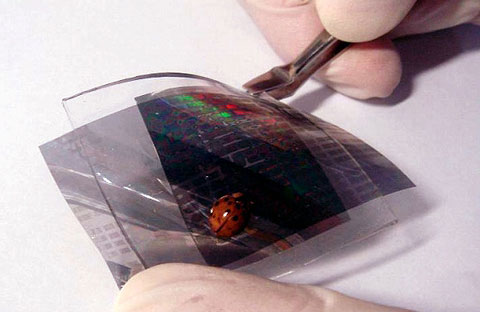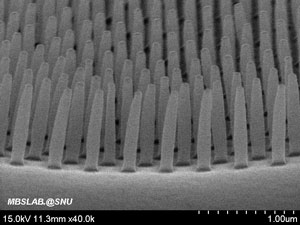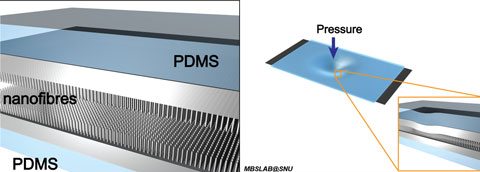Could This Be the Next Robotic Skin?
Nature often inspires scientists: glass with spiderweb patterns, a mirror-less laser inspired by bird feathers, and boat hull coatings designed after shark skin are but a few examples. Now ladybug hairs that lock their wings against their bodies have inspired a research group in Seoul, Korea to design a flexible electronic sensor that can detect when the slightest push, twist, or slide acts on it!

A ladybug walking across the flexible sensor.
Image Credit: Multiscale Biomimetic Systems Laboratory at Seoul National University, Seoul, Korea
From Ladybug to Laboratory
The sensor resembles two brushes sandwiched together. The bristles of each brush are a flexible polymer fiber with a length of about one micron (a millionth of a meter, 1 µm), and a diameter of about one tenth of a millionth of a meter (0.1 µm).1 To make the fibers good electrical conductors, they are coated with a thin layer (20 billionths of a meter, 20nm) of platinum.1 Researchers at The Multiscale Biomimetic Laboratory at Seoul National University in Korea designed the sensor.
Ladybugs inspired the sensor’s bristles, which resemble the small hairs found on ladybugs’ wings and body.1 Ladybug hairs interlock when the wing rests on the body, and a static electric force (van der Waal’s force) between molecules holds the wing in place.

A scanning electron microscope image of the sensor. The polymer hairs are about one thousandth of a millimeter and have a diameter of about one tenth of a thousandth of a millimeter.
Image Credit: MBSLab at Seoul National University, Seoul, Korea
To build the sensor, researchers placed the sensor’s hairs on a flexible pad made of polydimethylsiloxane (PDMS). The two hairy layers are then put together. Two platinum wires connect the interlocking hairs, allowing electrical signals to be detected with other instruments.1
When interlocked, the sensors give rise to the attractive van der Waal’s force that mimics the ladybug wings’ locking power. The slightest touch to the outside of this device changes the location of the hairs inside, causing a measurable change in the electric resistance.
The research group analyzed how the resistance changed due to a slight pressure force, (up or down direction), a shear force (sliding along surface), or a torsional force (twisting). They repeatedly measured the change in relative resistance for each of these types of forces, and they were able to reproduce their results for about 10,000 cycles – the point when the system began to degrade.1
Each type of applied force (pressure, shear, and torsional) resulted in a unique change in the contact between neighboring nanofibers, and hence a unique change in relative resistance measured. When applying a combination of these three forces simultaneously to the sensor, the researchers were able to determine from their measurements the amount of each force acting on the sensor.

Illustrations of the sensor and pressure applied to the sensor.
Image Credit: MBSLab at Seoul National University, Seoul, Korea.
A downward pressure force pushes the fibers together, and the resistance drops in a unique, repeatable, and predictable way for different pressures. In fact, the researchers found a linear relationship between the relative change in resistance and how much the sensor is deformed (strain) over a 2% decrease in the sensor’s shape.1
As the shear force increases, (trying to push the top layer over the bottom layer) the fibers begin to bend and angle over each other, making more contact. Like the pressure force, the researchers found a linear relationship between the relative change in resistance and the deformation of the sensor over a 4% change in the sensor’s shape.
The torsional force causes the fibers to twist and push along the sides of other fibers. This also results in a linear relationship between the relative change in resistance and the deformation of the sensor, but this time for changes of up to 5% of the sensor’s shape.1
This sensor is so sensitive that it can detect and measure a heartbeat, a water droplet bouncing on it, and the movement of ladybugs walking along its surface!
What's Next?
According to Dr. Changhyun Pang, a researcher in Kahp-Yang Suh’s group at Seoul national university, these sensors may find applications in “smart and flexible devices for touch screen, robot technology (artificial skin), and wearable medical devices for in vitro diagnostics.”
Kahp-Yang Suh also noted that the device is currently under investigation for use as a “theranostic medical patch incorporating dual functions of bio-signal monitoring and drug delivery.” Theranostics individualizes detection, monitoring, and intervention in medical applications.
The researchers are also conducting a theoretical analysis of the physical system to better understand how to control its sensitivity over wide ranges of applied forces. This analysis should also enhance its wearability.
The development of this sensor and the development of electronic circuit tattoos3 may significantly change health care and robotics.
References and Links
- Pang, C. et al., "A flexible and highly sensitive strain-gauge sensor using reversible interlocking nanofibers,” Nature Materials, (11) 795-801 (2012).
http://www.nature.com/nmat/journal/v11/n9/fig_tab/nmat3380_ft.html - Bourzac, K, “Electronic sensor rivals sensitivity of human skin,” Nature News, 29 July 2012
http://www.nature.com/news/electronic-sensor-rivals-sensitivity-of-human-skin-1.11081 - Doss, H.M., "Electronic Tattoos," Physics Central
http://www.physicscentral.com/explore/action/tattoos1.cfm
—H.M. Doss














